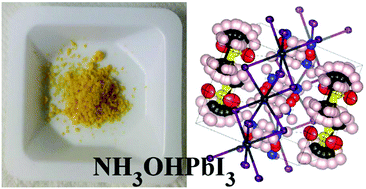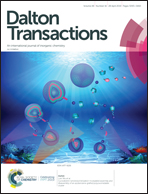Synthesis, physico-chemical characterization and structure of the elusive hydroxylammonium lead iodide perovskite NH3OHPbI3†
Abstract
The synthesis of hydroxylammonium lead iodide NH3OHPbI3 was accomplished by means of the reaction between water solutions of HI and NH2OH with PbI2 in sulfolane in conjunction with either crystallization by CH2Cl2 vapor diffusion or sulfolane extraction with toluene. The appropriate choice of the solvent was found to be crucial in order to attain the desired material. The synthesized compound was extensively characterized by single crystal and powder X-ray diffraction, UV-Vis diffuse reflectance spectroscopy, FT-IR spectroscopy, 1H-NMR spectroscopy, TG-DTA-QMS EGA (Evolved Gas Analysis), ESI-MS, and CHNS analysis. NH3OHPbI3 is an extremely reactive, deliquescent solid that easily oxidizes in air releasing iodine. Furthermore, it is the first reported perovskite to melt (m.p. around 80 °C) before decomposing exothermally at 103 °C. Such a chemical behavior, together with its optical absorption properties (i.e. yellow-colored perovskite), renders this material totally unsuitable for photovoltaic applications. The deliquescence of the material is to be ascribed to the strong hydrophilicity of hydroxylammonium ion. On the other hand, the relatively high Brønsted acidity of hydroxylammonium (pKa = 5.97) compared to other ammonium cations, promotes the reduction of atmospheric oxygen to water and the NH3OHPbI3 oxidation. The crystal structure, determined by single crystal X-ray diffraction with synchrotron radiation, is orthorhombic, but differs from the prototypal perovskite structure. Indeed it comprises infinite chains of face-sharing PbI6 octahedra along the c-axis direction with hydroxylammonium cations positioned between the columns, forming layers on the ac plane. The solvent intercalates easily between the layers. The crystal structure is apparently anomalous considering that the expected Goldschmidt's tolerance factor for the system (0.909) lies in the range of a stable prototypal perovskite structure. Therefore, the strong hydrogen bond forming tendency of hydroxylamine is likely to account for the apparent structural anomaly.



 Please wait while we load your content...
Please wait while we load your content...